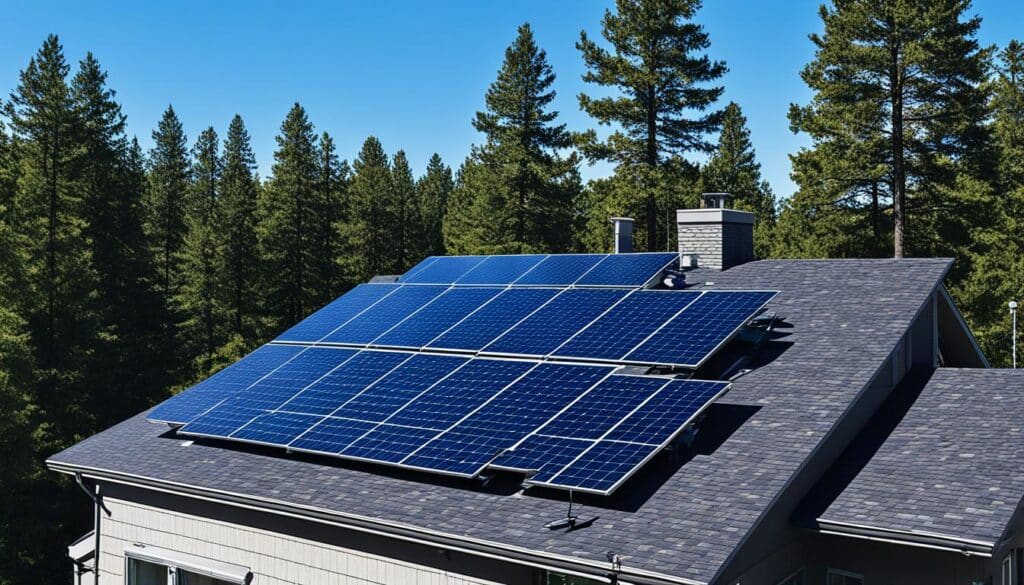
As we strive for a more sustainable future, renewable power sources like solar energy are gaining significant attention. In the United States, solar energy has become a driving force in the transition towards cleaner and greener power alternatives. Harnessing the power of the sun, solar energy offers numerous benefits that contribute to a more sustainable future.
Solar energy is a renewable source of power derived from the sun’s rays. By utilizing solar panels, which convert sunlight into electricity, we can tap into this abundant and clean energy source. Unlike fossil fuels that contribute to pollution and climate change, solar energy is sustainable and does not deplete any natural resources. It poses no harm to our environment or our health, making it an ideal choice for a cleaner energy future.
The United States has seen remarkable growth in solar energy adoption, with many states implementing policies and incentives to encourage its use. This growth stems from the wide array of benefits offered by solar energy. By generating our electricity from solar power, we can significantly reduce our electricity bills, providing financial savings for homeowners and businesses alike. Additionally, solar energy decreases our reliance on fossil fuels, reducing carbon emissions and combating climate change.
Embracing solar energy not only benefits our environment and our wallets but also contributes to a more sustainable future. By transitioning to solar power, the United States can continue its pursuit of sustainability goals and lead the way in renewable energy innovation.
Key Takeaways:
- Solar energy is a renewable and sustainable power source derived from the sun’s rays.
- Solar panels convert sunlight into electricity, providing a clean and abundant energy alternative.
- The United States has witnessed significant growth in solar energy adoption, with many states supporting its use through policies and incentives.
- Solar energy offers financial savings by reducing electricity bills and decreases reliance on fossil fuels.
- By embracing solar power, the United States can achieve sustainability goals and combat climate change.
The Process of Harnessing Solar Energy.
Solar energy is a sustainable and renewable source of power that is harnessed through the photovoltaic effect. This process occurs when sunlight stimulates electrons in silicon cells, generating electric currents. The key component in capturing solar energy is the use of solar panels, which are made up of multiple photovoltaic cells.
There are different types of solar panel systems that can be used to harness solar energy. Let’s explore three common types: grid-tied systems, off-grid systems, and hybrid systems.
Grid-tied Systems
Grid-tied systems are the most common type of solar panel system. These systems are connected to the local utility grid, allowing homeowners to use municipal power when the solar output is low. When the solar panels produce excess electricity, it is fed back into the grid, and homeowners receive credits or compensation for the energy they contribute. Grid-tied systems are popular because they provide the benefit of both solar energy and the reliability of the utility grid.
Off-grid Systems
Off-grid systems, also known as standalone systems, are independent of the utility grid. These systems are designed to provide complete energy independence, especially in remote areas where access to the grid may be challenging. Off-grid systems typically incorporate battery storage to store excess energy generated during the day for use at night or during periods of low sunlight. This ensures a continuous and reliable power supply even without access to the grid.
Hybrid Systems
Hybrid systems combine the best of both worlds: the benefits of grid-tied and off-grid systems. These systems can switch between drawing power from the grid and utilizing stored energy from battery storage. Hybrid systems allow homeowners to maximize their solar energy usage while still having the backup support of the utility grid. This flexibility provides energy independence and reliability, making hybrid systems an increasingly popular choice.
Understanding the different types of solar panel systems is crucial in determining the most suitable option for your energy needs. Whether it’s a grid-tied system, an off-grid system, or a hybrid system, harnessing solar energy can provide financial savings, reduce reliance on fossil fuels, and contribute to a cleaner and more sustainable environment.

| Solar Panel System Type | Key Features |
|---|---|
| Grid-tied Systems | Connected to the utility grid, allows for energy exchange and compensation, reliable power supply during low solar output |
| Off-grid Systems | Independent of the utility grid, battery storage for reliable power supply, suitable for remote areas |
| Hybrid Systems | Combination of grid-tied and off-grid features, flexible energy usage, reliable power supply with grid backup |
Benefits of Solar Energy in the US.
Solar energy offers numerous benefits in the US. By harnessing the power of the sun, homeowners and businesses can enjoy reduced electricity bills, decreased reliance on fossil fuels, and contribute to a cleaner environment. Let’s explore these advantages in more detail.
1. Reduced Electricity Bills
Solar panels generate free electricity from sunlight, reducing the need to purchase electricity from traditional sources. By utilizing solar energy, homeowners can significantly lower their electricity bills, resulting in long-term cost savings. The money saved can be allocated towards other essential expenses or invested in further sustainability measures.
2. Decreased Reliance on Fossil Fuels
Solar energy is a renewable and sustainable source of power. By embracing solar technologies, individuals and businesses can decrease their reliance on non-renewable fossil fuels, such as coal, oil, and natural gas. This shift helps reduce the overall carbon footprint and mitigates the negative impact of these fuels on the environment.
3. Cleaner Environment
Unlike conventional energy production methods, solar energy systems do not produce harmful emissions during operation. By switching to solar power, individuals and businesses can contribute to a cleaner and healthier environment. Solar energy helps combat climate change by reducing greenhouse gas emissions and minimizing air and water pollution.
“Solar energy not only benefits our wallets but also the planet we call home. By harnessing the power of the sun, we can create a sustainable future for generations to come.” – [insert real name of an environmental advocate]
The Environmental Impact of Solar Energy
The adoption of solar energy has a significant positive impact on the environment. Here are some key environmental benefits:
- Reduces carbon emissions and helps combat climate change
- Minimizes air and water pollution
- Preserves natural resources by reducing the need for fossil fuels
- Decreases dependence on foreign energy sources
By transitioning to solar energy, the US can make significant progress towards achieving its sustainability goals and creating a healthier planet for future generations.

| Benefits | Reduced Electricity Bills | Decreased Reliance on Fossil Fuels | Cleaner Environment |
|---|---|---|---|
| Cost Savings | ✔ | ||
| Sustainability | ✔ | ✔ | |
| Environmental Impact | ✔ | ✔ |
Conclusion
Solar energy is a renewable power source with immense potential for the United States. Its ability to reduce electricity bills, decrease reliance on fossil fuels, and contribute to a cleaner environment makes it highly beneficial. By harnessing the power of the sun, we can make significant strides towards achieving sustainability goals and transitioning to a more renewable energy future.
The benefits of solar energy are far-reaching. By utilizing solar panels, homeowners can significantly reduce their electricity bills, saving money in the long run. Moreover, solar energy reduces our dependence on fossil fuels, which not only deplete finite resources but also contribute to harmful greenhouse gas emissions.
Embracing solar energy is a crucial step towards a cleaner and more sustainable future. The transition to renewable power sources like solar energy will play a key role in combating climate change and protecting our environment for future generations.
FAQ
What is solar energy?
Solar energy is a renewable source of power that comes from the sun. It is harnessed through the use of solar panels, which convert sunlight into electricity.
How is solar energy harnessed?
Solar energy is harnessed through the photovoltaic effect, where sunlight stimulates electrons in silicon cells, generating electric currents. Solar panels, consisting of multiple photovoltaic cells, are the main component of a solar energy system.
What are the different types of solar panel systems?
There are different types of solar panel systems, including grid-tied, off-grid, and hybrid systems. Grid-tied systems are connected to the local utility grid and allow homeowners to use municipal power when solar output is low. Off-grid systems provide complete energy independence with battery storage. Hybrid systems combine the strengths of both grid-tied and off-grid systems.
What are the benefits of solar energy in the US?
Solar energy offers numerous benefits in the US. One of the primary advantages is the potential for reduced electricity bills, as solar panels generate free electricity from sunlight. By using solar energy, homeowners can decrease their reliance on fossil fuels, which are non-renewable and contribute to greenhouse gas emissions. Solar energy is a clean and sustainable source of power, as it does not produce any harmful emissions during operation.
Source Links
- https://original.newsbreak.com/@solarpowersys-1881282/3333707873012-solar-cheat-sheet-your-guide-to-getting-solar-panels-in-cullman-alabama
- https://www.slideteam.net/blog/top-5-marketing-outreach-plan-templates-with-samples-and-examples
- https://financialpost.com/globe-newswire/birchcliff-energy-ltd-announces-unaudited-2023-full-year-and-fourth-quarter-results-and-2023-reserves-highlights








